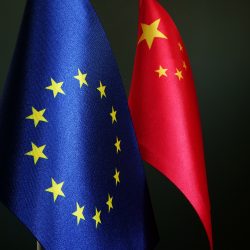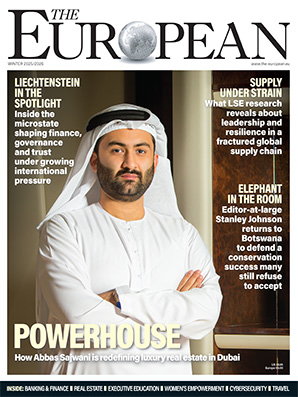In turbulent times, China and the EU need to collaborate

There is no doubt that we live in times where free trade is under pressure, with a rise in protectionism observed across the globe. A growing number of countries impose tariffs and other trade restrictions in order to shield their own markets from foreign competition.
The shift in the US position towards globalisation is an important factor behind the current protectionist climate. President Trump has imposed steep tariffs, withdrawn or renegotiated regional trade agreements and impeded the functioning of international organisations, including the World Trade Organisation. His aim is to reduce the US trade deficit and to create jobs in US manufacturing. His main targets are China and Europe.
The Chinese President Xi Jinping is positioning his country as a proponent of globalisation. He wants to avoid a trade war but is not hesitant to retaliate against US protectionist measures. At the same time, China is unfolding its ambitious Belt and Road Initiative (BRI) aimed at connecting Asia with Africa and Europe through land and maritime networks. From the Chinese point of view this initiative will promote regional integration, increase trade flows and stimulate economic growth.
The EU’s international trade position is facing profound challenges. Inside the EU, the endless Brexit saga is creating a great deal of uncertainty. For sure, UK trade flows will suffer most from Brexit but the trade performance of several EU countries will be negatively affected as well. In its relationship with the rest of the world, the EU can no longer depend on the support of its main trading partner, the US. In response, the EU has been very active in negotiating free trade agreements with preferred trading partners, such as Canada, Japan, Australia, the MERCOSUR countries, Singapore and the ASEAN member states.
Conspicuous by its absence
Surprisingly, China is not on the list of preferred trading partners with whom the EU is considering a comprehensive trade agreement. This is striking because bilateral trade and investment flows between China and the EU have grown strongly. China has become the EU’s second most important trade partner after the US, whilst the EU is China’s foremost trade partner. During the past 15 years, the EU saw an increase in its export figures to China, from less than 5% to 10% of its total exports to non-EU countries. Looking at the sectoral pattern of bilateral trade flows between China and the EU, one finds that the EU is specialised in the exports of transport material, optical instruments, and photo and film equipment. China has become the biggest exporter of high-tech products to the EU involving electronics, telecom and digital equipment.
The strong expansion of bilateral trade is not the only reason why China and the EU could both benefit from a closer alignment of their trade and investment strategies. Both sides benefit from open markets and globalisation. Research reveals a strong correlation between the annual growth of world trade and the annual growth of individual EU member states. Similarly, the growth in international trade is an important engine for the growth of the Chinese economy. Hence, both sides benefit from joint efforts to keep markets open, to resist protectionism and to prevent a trade war.
Why then is the EU not negotiating a free trade agreement with China? One reason may be the trade imbalance. The EU trade deficit in goods with China amounted to €184.8bn in 2018. The size of the trade deficit does not cause the same policy concern in the EU as it does the US, however. After all, the EU runs a small trade surplus in its global trade balance meaning that the deficit with China is more than compensated by the EU trade surplus with the rest of the world. However, what does worry European policymakers is that high technology products account for nearly 50% of the trade deficit with China. One main strategy priority for the EU is to maintain a strong global position in knowledge-intensive sectors and not to become overly dependent on foreign suppliers for crucial technologies and infrastructure. The rising prominence of Chinese high-tech exports reflects the ambition of China to become the world’s technological powerhouse. To many in Europe this is seen as a strategic threat. A closer relationship between the EU and China is not evident when the strategic objectives of both partners clash.
Mutual benefits
So, how can the risk of conflicts be reduced? And what are some of the options to deepen the relationship between the EU and China? The risk of technological conflict can be reduced by entering into technological cooperation in areas where China and Europe face common societal challenges. Healthcare is one example because European and Chinese societies are rapidly ageing. Technology is equally important for addressing environmental pollution and the impact of climate change.
A necessary condition for a good business relationship between the EU and China is the acceptance of the “reciprocity principle”. Reciprocity means that one partner is willing to open up its market provided that the other partner does the same thing. The EU is concerned about the market access of European companies to the Chinese market. It wants to get rid of restrictions that forces European companies to engage in joint-ventures and share their technological know-how with a Chinese partner when investing in the Chinese market. Moreover, it wants China to observe multilateral rules with regards to subsidies and intellectual property. From the Chinese perspective, reciprocity implies that Chinese investors should be allowed to acquire European companies and that individual Chinese companies should not targeted by European governments as happened in the Huawei case recently.
Another area of cooperation relates to the Belt and Road Initiative (BRI). So far, the European reaction has been divided with some EU member countries participating in the initiative while others refuse to do so. Critics view the BRI as a Trojan horse that undermines unity in the EU and runs the risk of burdening poorer European countries with heavy debts. Proponents of the BRI point to the benefits of much-needed investments in transport infrastructure. Since several European countries are directly or indirectly affected, enhanced cooperation between the EU and China in BRI-related projects seems to be the logical way forward. The creation of a China-EU Co-investment Fund in 2017 represents an important decision in this regard. This fund is expected to provide €500m, jointly backed by the European Investment Fund and the Chinese Silk Road Fund, to equity investments in BRI projects.
Finally, both parties could revitalise the existing China-EU Cooperation Agreement. During the last EU-China summit meeting in April 2019, both partners committed to a deepening and broadening of the agenda of this strategic partnership in the period beyond 2020. If successful, the closer collaboration in a growing number of areas of mutual interest could in the future lay the foundations for a comprehensive free trade agreement between the EU and China.
For more world business news, follow The European


